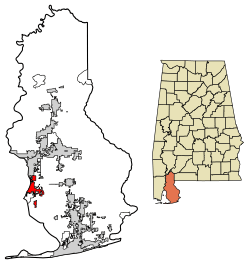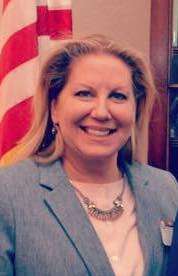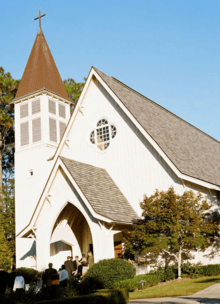Fairhope, Alabama
Fairhope is a city in Baldwin County, Alabama, United States on the eastern shoreline of Mobile Bay. The 2010 census lists the population of the city as 15,326.[4] Fairhope is a principal city of the Daphne-Fairhope-Foley micropolitan area, which includes all of Baldwin County. In 2016, Fairhope was named the best small town in the South by Southern Living magazine.[5]
Fairhope | |
|---|---|
 Fairhope Public Library | |
| Motto(s): "You've arrived" | |
 Location of Fairhope in Baldwin County, Alabama. | |
| Coordinates: 30°31′35″N 87°53′44″W | |
| Country | United States |
| State | Alabama |
| County | Baldwin |
| Government | |
| • Type | Municipality |
| • Mayor | Karin Wilson |
| Area | |
| • Total | 14.13 sq mi (36.59 km2) |
| • Land | 14.07 sq mi (36.45 km2) |
| • Water | 0.06 sq mi (0.14 km2) |
| Elevation | 122 ft (37 m) |
| Population | |
| • Total | 15,326 |
| • Estimate (2019)[3] | 22,677 |
| • Density | 1,611.15/sq mi (622.09/km2) |
| Time zone | UTC−6 (Central (CST)) |
| • Summer (DST) | UTC−5 (CDT) |
| ZIP code | 36532–36533 |
| Area code(s) | 251 |
| FIPS code | 01-25240 |
| GNIS feature ID | 0118120 |
| Website | Official website |
History
Fairhope was founded in November 1894 on the site of the former Alabama City as a radical, utopian socialist Georgist "Single-Tax" colony by the Fairhope Industrial Association, a group of 28 followers of economist Henry George who had incorporated earlier that year in Des Moines, Iowa.[6] Their corporate constitution explained their purpose in founding a new colony:
to establish and conduct a model community or colony, free from all forms of private monopoly, and to secure to its members therein equality of opportunity, the full reward of individual efforts, and the benefits of co-operation in matters of general concern.[7]
In forming their demonstration project, they pooled their funds to purchase land at "Stapleton's pasture" on the eastern shore of Mobile Bay and then divided it into a number of long-term leaseholds. The corporation paid all governmental taxes from rents paid by the lessees, thus simulating a single-tax. The purpose of the single-tax colony was to eliminate disincentives for productive use of land and thereby retain the value of land for the community.[8]
"Fairhope Avenue" was one of the properties on the 1910 version of the board game The Landlord's Game, a precursor of Monopoly.[9]
In 1907 educator Marietta Johnson founded the School for Organic Education in Fairhope. The school was praised in John Dewey's influential 1915 book Schools of Tomorrow. Dewey and Johnson were founding members of the Progressive Education Association.
Fairhope became a popular wintering spot for artists and intellectuals. Sherwood Anderson, Clarence Darrow, Wharton Esherick, Carl Zigrosser, and Upton Sinclair were among its notable visitors.[10]
The Fairhope Single-Tax Corporation still operates, with 1,800 leaseholds covering more than 4,000 acres (16 km2) in and around the current city of Fairhope. Despite the ideals of the corporation, the town has transitioned from utopian experiment to artists' and intellectuals' colony to boutique resort and affluent suburb of Mobile.[7] White flight from nearby Mobile has caused the population of Baldwin County to almost triple since the 1940s,[11] and particularly since desegregation, contributing to the mostly-White demographics of Daphne, Fairhope, and Spanish Fort.[12]
Geography
Fairhope is located on the shore of Mobile Bay. It is located 6 miles (10 km) south of Daphne and 10 miles (16 km) south of Spanish Fort. U.S. Route 98 (Greeno Road) runs north–south through the city. It lies on a sloping plateau.
According to the U.S. Census Bureau, the city has a total area of 12.0 square miles (31.1 km2), of which 0.019 square mile (0.05 km2), or 0.16%, is water.[4] Its elevation ranges from sea level at the bay to 122 feet (37 m) in the city center.[13]
Climate
Fairhope has a humid subtropical climate. It experiences hot, humid summers and generally mild winters, with average temperatures ranging from 81.9 °F (27.7 °C) in the summer to 50.4 °F (10.2 °C) during winter.
| Climate data for Fairhope, 1981–2010 normals, extremes 1917–present | |||||||||||||
|---|---|---|---|---|---|---|---|---|---|---|---|---|---|
| Month | Jan | Feb | Mar | Apr | May | Jun | Jul | Aug | Sep | Oct | Nov | Dec | Year |
| Record high °F (°C) | 85 (29) |
88 (31) |
88 (31) |
97 (36) |
98 (37) |
103 (39) |
105 (41) |
103 (39) |
105 (41) |
97 (36) |
94 (34) |
89 (32) |
105 (41) |
| Mean maximum °F (°C) | 75.2 (24.0) |
77.6 (25.3) |
81.4 (27.4) |
85.4 (29.7) |
91.2 (32.9) |
94.4 (34.7) |
96.1 (35.6) |
95.6 (35.3) |
93.6 (34.2) |
88.9 (31.6) |
82.4 (28.0) |
77.6 (25.3) |
97.2 (36.2) |
| Average high °F (°C) | 61.4 (16.3) |
64.8 (18.2) |
71.2 (21.8) |
77.5 (25.3) |
84.7 (29.3) |
89.3 (31.8) |
91.1 (32.8) |
91.0 (32.8) |
87.9 (31.1) |
80.1 (26.7) |
71.6 (22.0) |
63.6 (17.6) |
77.9 (25.5) |
| Daily mean °F (°C) | 50.4 (10.2) |
53.7 (12.1) |
60.0 (15.6) |
66.3 (19.1) |
74.1 (23.4) |
79.9 (26.6) |
81.9 (27.7) |
81.7 (27.6) |
77.7 (25.4) |
68.7 (20.4) |
60.2 (15.7) |
52.7 (11.5) |
67.3 (19.6) |
| Average low °F (°C) | 39.5 (4.2) |
42.6 (5.9) |
48.8 (9.3) |
55.1 (12.8) |
63.6 (17.6) |
70.5 (21.4) |
72.7 (22.6) |
72.3 (22.4) |
67.6 (19.8) |
57.3 (14.1) |
48.7 (9.3) |
41.8 (5.4) |
56.7 (13.7) |
| Mean minimum °F (°C) | 23.1 (−4.9) |
26.6 (−3.0) |
32.6 (0.3) |
40.9 (4.9) |
51.5 (10.8) |
62.5 (16.9) |
67.4 (19.7) |
67.1 (19.5) |
55.9 (13.3) |
41.9 (5.5) |
32.3 (0.2) |
25.4 (−3.7) |
20.0 (−6.7) |
| Record low °F (°C) | 5 (−15) |
10 (−12) |
19 (−7) |
29 (−2) |
29 (−2) |
52 (11) |
58 (14) |
60 (16) |
41 (5) |
32 (0) |
21 (−6) |
8 (−13) |
5 (−15) |
| Average precipitation inches (mm) | 5.64 (143) |
5.56 (141) |
5.73 (146) |
4.44 (113) |
4.91 (125) |
6.60 (168) |
8.05 (204) |
7.20 (183) |
5.94 (151) |
4.25 (108) |
4.98 (126) |
4.57 (116) |
67.87 (1,724) |
| Average precipitation days (≥ 0.01 in) | 10.3 | 9.6 | 8.6 | 6.7 | 7.4 | 11.9 | 14.0 | 14.3 | 10.5 | 7.0 | 8.0 | 9.7 | 118.0 |
| Source: NOAA[14][15] | |||||||||||||
Demographics
| Historical population | |||
|---|---|---|---|
| Census | Pop. | %± | |
| 1910 | 590 | — | |
| 1920 | 853 | 44.6% | |
| 1930 | 1,549 | 81.6% | |
| 1940 | 1,845 | 19.1% | |
| 1950 | 3,354 | 81.8% | |
| 1960 | 4,858 | 44.8% | |
| 1970 | 5,720 | 17.7% | |
| 1980 | 7,286 | 27.4% | |
| 1990 | 8,485 | 16.5% | |
| 2000 | 12,480 | 47.1% | |
| 2010 | 15,326 | 22.8% | |
| Est. 2019 | 22,677 | [3] | 48.0% |
| U.S. Decennial Census[16] | |||
As of the census of 2010, there were 15,326 people, 6,732 households, and 4,395 families residing in the city. Its population density was 1,271 per square mile (491/km2). There were 7,659 housing units at an average density of 634.5 per square mile (245.0/km2). The racial makeup of the city was 91.1% White, 6.2% Black, 0.7% Asian, 0.2% Native American, 0.0% Pacific Islander, 0.9% from other races, and 0.8% from two or more races. 2.8% of the population were Hispanic or Latino of any race.
There were 6,732 households out of which 25.9% had children under the age of 18 living with them, 53.6% were married couples living together, 9.1% had a female householder with no husband present, and 34.7% were non-families. 31.2% of all households were made up of individuals and 17.1% had someone living alone who was 65 years of age or older. The average household size was 2.26 and the average family size was 2.84.
21.4% of the population was under the age of 18, 4.9% from 18 to 24, 20.4% from 25 to 44, 28.5% from 45 to 64, and 23.7% who were 65 years of age or older. The median age was 46 years. For every 100 females, there were 86.4 males. For every 100 females age 18 and over, there were 86.3 males. The median income for a household in the city was $66,157, and the median income for a family was $93,549. Males had a median income of $60,591 versus $36,218 for females. The per capita income for the city was $35,086. About 5.0% of families and 5.9% of the population were below the poverty line, including 9.8% of those under age 18 and 4.6% of those age 65 or over.
Government

Fairhope is governed by a mayor and five-person city council which was last elected in 2016. The mayor serves as the full-time city executive, while council members serve part-time.
Mayor: Karin Wilson.
Council members:
- Jack Burrell
- Jay Robinson
- Jimmy Conyers
- Robert Brown
- Kevin Boone
Development

Local and national real estate developers have built commercial facilities in the downtown area that are larger than have been historically allowed.[17]
Fairhope's building and zoning ordinances overlap with those of Baldwin County. Residents of the city want more control of construction projects near, but still outside the city limits, while residents outside the city limits want less city control of their property.[18]
Education
Fairhope's public schools are part of the Baldwin County Public Schools system:
- Fairhope High School (9–12) – 1,142 students, Principal Jon Cardwell.[19] Fairhope High School is located in the southernmost part of Fairhope. It is estimated that 39% of the city of Fairhope's high school age students attend Daphne High School that is north of Fairhope.
- Fairhope Middle School (7–8) – 642 students, Principal Angie Hall
- J. Larry Newton School (K–6) – 731 students, Principal Patrice Krueger, (Barnwell, Alabama)
- Fairhope Intermediate School (4–6) – 397 students, Princial
- Fairhope Elementary School (K–3) – 278 students, Principal
Other schools in Fairhope include:
- The Marietta Johnson School of Organic Education – continues to operate as a private school with approximately 20 students as of 2017. The school offers education to life groups that traditionally span 1st through 8th grades.
- St. Michael Catholic High School – beginning in 2016 with grades 9–10, adding a grade each year thereafter for a total enrollment between 360–400
- Bayshore Christian School – beginning in 2002 with Kindergarten, adding a grade each year thereafter, currently offering PreK-12th grade for a total enrollment between 440–480
- Faulkner State Community College – has a campus in Fairhope that provides adult education, undergraduate courses, non-credit and community service programs
- The University of South Alabama – has a branch campus in Fairhope providing graduate and upper-level undergraduate courses in education, counseling, nursing and business alongside non-credit and community service programs
Notable people
- Pinky Bass, photographer
- Bob Baumhower, football player and businessman
- Rick Bragg, writer
- Jimmy Buffett, singer and songwriter
- Grayson Capps, singer songwriter
- Eugenia S. Chapman, educator and Illinois state representative
- Dave Edwards, musician
- Grant Enfinger, professional race car driver
- Fannie Flagg, author and actress
- Abbi Glines, writer
- Fred Nall Hollis (Nall), artist
- Marie Howland, utopian and journalist
- Marietta Johnson, educator and reformer
- David King, former NFL defensive back
- Leon Lett, football player
- Dean Mosher, artist, author, and historian
- George M. Murray, bishop in the Episcopal Church
- Burton Ritchie, entrepreneur
- Janie Shores, Alabama Supreme Court justice
- Eddie Stanky, Major League Baseball player and manager
- Dave Stapleton, former baseball player
- Thompson Square, country music duo[20]
- Bill Varney, film sound editor[21]
- Bob Weltlich, former college basketball coach
See also
References
- "2019 U.S. Gazetteer Files". United States Census Bureau. Retrieved June 29, 2020.
- "Population Estimates". United States Census Bureau. Archived from the original on May 22, 2014. Retrieved June 7, 2014.
- "Population and Housing Unit Estimates". United States Census Bureau. May 24, 2020. Retrieved May 27, 2020.
- "Geographic Identifiers: 2010 Demographic Profile Data (G001): Fairhope city, Alabama". U.S. Census Bureau, American Factfinder. Archived from the original on February 12, 2020. Retrieved September 9, 2013.
- Lucy Berry (February 23, 2016). "2 Alabama cities among Southern Living's 2016 Best Small Towns in the South". Press-Register. Archived from the original on September 18, 2016. Retrieved February 2, 2017.
- "Archived copy". Archived from the original on May 15, 2011. Retrieved April 29, 2011.CS1 maint: archived copy as title (link)
- "Fairhope Single Tax Corporation". Fairhope Single Tax Corporation. Archived from the original on September 19, 2017. Retrieved October 22, 2017.
- "Archived copy". Archived from the original on May 15, 2011. Retrieved April 29, 2011.CS1 maint: archived copy as title (link)
- "Game Rules – The Landlord's Game – Economic Game Company". landlordsgame.info. Archived from the original on August 9, 2017. Retrieved October 22, 2017.
- Lauren Coodley. (2013) Upton Sinclair: California Socialist, Celebrity Intellectual. Lincoln, Nebraska: University of Nebraska Press. 2013
- Tynes, Gabriel (October 22, 2015). "Baldwin's population soars as whites flee Mobile". Lagniappe Mobile. Retrieved July 16, 2020.
- Bagley, Joseph (2018). The Politics of White Rights: Race, Justice, and Integrating Alabama's Schools. U of Georgia P. p. 212. ISBN 9780820354194.
- Census Gazetteer, 2010, webpage: "Archived copy". Archived from the original on January 12, 2012. Retrieved November 25, 2012.CS1 maint: archived copy as title (link).
- "National Weather Service Climate". National Oceanic and Atmospheric Administration. Retrieved May 4, 2013.
- "WMO Climate Normals for Fairhope 2 NE". National Oceanic and Atmospheric Administration. Retrieved November 18, 2017.
- United States Census Bureau. "Census of Population and Housing". Retrieved August 10, 2013.
- History of Fairhope 1954-present Mobile: Putman, 2006
- Knight, Paul (June 29, 2007). "Residents call for increased accountability". Mobile Register (Mobile) (newspaper). Advance Publications. p. Baldwin Register, 01.
- "Fairhope High School / Homepage". www.fairhopehs.com. Archived from the original on February 3, 2014. Retrieved October 22, 2017.
- "For Thompson Square, Nashville is Work and Fairhope is Home". The Southern Rambler. Archived from the original on December 15, 2017. Retrieved February 2, 2017.
- "Harold William (Bill) Varney". Press-Register. Archived from the original on July 24, 2011. Retrieved April 9, 2011.
Further reading
- Dian Arnold. (1999) "Fairhope: A Sentimental Review." link
- Paul E. and Blanche R. Alyea. (1956) "Fairhope, 1894–1954: The Story of a Single Tax Colony." Tuscaloosa: University of Alabama Press.
- Paul M. Gaston. (1984) Women of Fair Hope. Athens, Georgia: University of Georgia Press. Black Belt Press, 1993.
- Paul M. Gaston. (1993) Man and Mission: E. B. Gaston and the Origins of the Fairhope Single Tax Colony. Montgomery, Alabama: Black Belt Press.
- Paul M. Gaston (2010) "Coming of Age in Utopia: The Odyssey of an Idea." Montgomery and Louisville: NewSouth Books.
- Paul M. Gaston. (2004) "My Yellow Ribbon Town: A Meditation on My Country and My Home." in Where We Stand: Voices of Southern Dissent. Montgomery, Alabama: New South Books. link
- Paul M. Gaston. (1985) "Gaston, Ernest Berry." in "Alden Whitman, ed., "American Reformers. New York: The H.W. Wilson Co.
- Mary Lois Timbes and Robert E. Bell. (2001) "Meet Me at the Butterfly Tree: A Fairhope Memoir." Fairhope: Over the Transom.
- Cathy Donelson, foreword by Fannie Flagg. (2005) "Fairhope." Charleston, South Carolina: Arcadia Publishing.
- Cathy Donelson. (2013) "Fairhope in the Roaring Twenties." Charleston, South Carolina: Arcadia Publishing.
